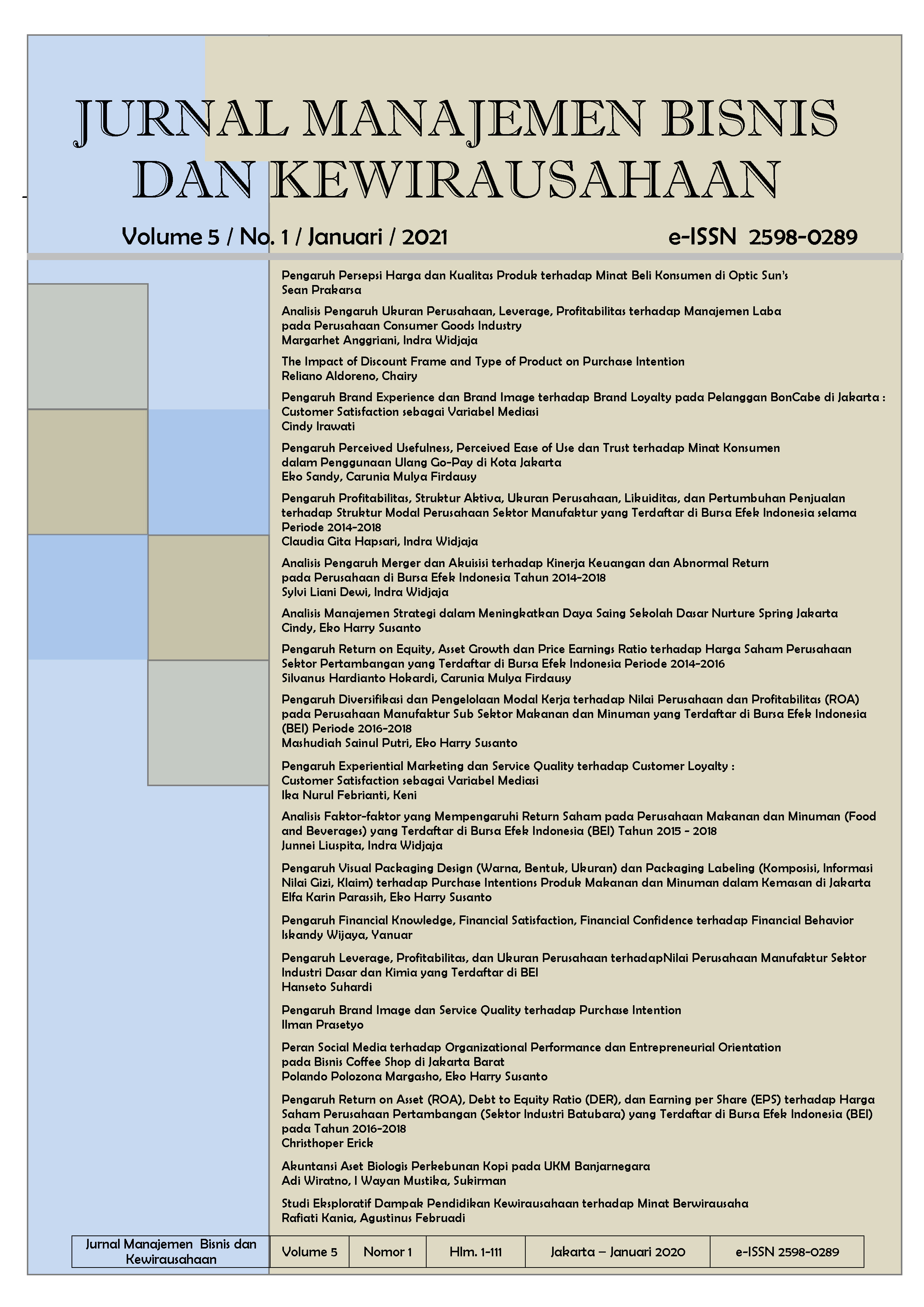Pengaruh Perceived Usefulness, Perceived Ease of Use dan Trust terhadap Minat Konsumen dalam Penggunaan Ulang Go-Pay di Kota Jakarta
Main Article Content
Abstract
The number of E-Wallet users in Indonesia keep increasing every year since it’s first launching. Several E-Wallet brands compete to be the best E-Wallet in Indonesia. One of them is Go-Pay. This research aims to find out the effect of perceived usefulness, perceived ease of use, and trust on intention to reuse of Go-Pay in Jakarta. A descriptive quantitative research was conducted by analysing data collected from online questionaire survey of 105 respondents. The method to analyse the data is by using multiple linear regression. The result showed that, perceived usefulness did not affect the reuse intention of Go-Pay customers significantly. Whilst perceived ease of use and trust did affect the reuse intention of Go-Pay customers significantly. Trust value has the strongest relationship toward reuse intention of Go-Pay customers. Therefore, Go-Pay company needs to maintain customers trust and also increase or retain Go-Pay application ease of use in doing payment.
Jumlah transaksi dan pengguna E-Wallet terus bertambah setiap tahunnya sejak pertama kali diluncurkan. Beberapa perusahaan E-Wallet saling bersaing untuk menjadi E-Wallet terbaik di Indonesia, salah satu perusahaan E-Wallet adalah Go-Pay. Penelitian ini memiliki tujuan untuk mencari pengaruh perceived usefulness, perceived ease of use, dan trust terhadap intention to reuse Go-Pay di Jakarta. Penelitian deskriptif kuantitatif dipilih dan dilakukan terhadap 105 data responden terpilih. Teknik Analisa regresi linear berganda dipilih dan diolah menggunakan perangkat lunak SPSS 24. Hasil menunjukkan bahwa perceived usefulness tidak memiliki pengaruh yang signifikan terhadap intention to reuse konsumen Go-Pay, namun perceived ease of use dan trust berpengaruh secara signifikan terhadap intention to reuse konsumen Go-Pay. Trust mendapatkan nilai signifikansi yang lebih tinggi terhadap intention to reuse konsumen Go-Pay. Sebagai kesimpulan, hasil penelitian dapat memberikan saran kepada perusahaan Go-Pay untuk mempertahankan kepercayaan konsumen serta meningkatkan atau mempertahankan kemudahan dalam melakukan transaksi menggunakan Go-Pay.
Article Details
This work is licensed under a Jurnal Manajemen Bisnis dan Kewirausahaan Creative Commons Attribution-ShareAlike 4.0 International License.
References
Ajzen, I., & Fishbein, M. A. (1975). Belief, Attitude, Intention and Behaviour : An Introduction to Theory and Research. Reading, MA : Addison-Wesley.
Bagla, R. K., & Sancheti, V. (2018). Gaps in Customer Satisfaction with Digital Wallets : Challenge For Sustainability. Journal of Management Development, 37 (6), 442-452.
Curvelo, I. C. (2019). Purchase Intention of Organic Food under The Influence of Attributes, Consumer Trust and Perceived Value. Revista de Gestão, 26 (3), 198-211.
Davis, F. D. (1989). Perceived Usefulness, Perceived Ease of Use, and User Acceptance of Information Technology. MIS Quarterly, 13 (3), 319-340.
Gong, X., Liu, Z., Zheng, X., & Wu, T. (2018). Why are Experienced Users of WeChat Likely to Continue Using The App? Asia Pacific Journal of Marketing and Logistics, 30 (4), 1013-1039.
Hatammimi, J. (2015). Factors Affecting the Intention to Reuse Mobile Banking Service. International Journal of Research in Business and Social Science, 4 (4).
Humbani, M., & Wiese, M. (2019). An Integrated Framework for The Adoption and Continuance Intention to Use Mobile Payment Apps. International Journal of Bank Marketing.
Kumar, A., Adlakaha, A., & Mukherjee, K. (2018). The Effect of Perceived Security and Grievance Redressal on Continuance Intention to Use M-Wallets in A Developing Country. International Journal of Bank Marketing, 36 (7), 1170-1189 .
Maia, C., Lunardi, G., & Munhoz, A. L. (2017). Factors and Characteristics that Influence Consumers’ Participation in Social Commerce. Revista de Gestão, 25 (2), 194-211.
Maqableh, M., Masa’deh, R. M., Shannak, R. O., & Nahar, K. M. (2015). Perceived Trust and Payment Methods : An Empirical Study of MarkaVIP Company. International Journal of Communications, Network and System Sciences, 8 (11), 409-427.
Ong, C. S., & Lin, Y. L. (2015). Security, Risk, and Trust in Individuals' Internet Banking Adoption : An Integrated Model. International Journal of Electronic Commerce Studies, 6 (2), 343-356.
Shidiq, M. J., & Warnilah, A. I. (2019). Analisis Penerimaan Grup Whatsapp sebagai Media Komunikasi dan Diskusi Guru. Indonesian Journal on Computer and Information Technology, 4 (2), 122-131.
Sikri, A., Dalal, S., Singh, N. P., & Le, D.-N. (2019). Mapping of E-Wallets with Features. Cyber Security in Parallel and Distributed Computing, 245 - 262.
Singh, N., Srivastava, S., & Sinha, N. (2017). Consumer Preference and Satisfaction Of M-Wallets : A Study on North Indian Consumers. International Journal of Bank Marketing, 35 (6), 944-965.
Zhu, D. H., Lan, L. Y., & Chang, Y. P. (2017). Understanding the Intention to Continue Use of a Mobile Payment Provider : An Examination of Alipay Wallet in China. International Journal of Business and Information, 12 (4), 369-390.


